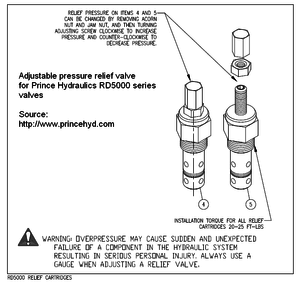Documentation/Video/Scripts/LifeTrac II/Valves
The LifeTrac is a hydraulically-driven tractor with modular engine units, the Power Cubes. The Power Cubes produce hydraulic fluid that flows through hoses, where the hoses are effectively the power transmission system. Each hose can handle up to 50 horsepower. Valves control the flow of the fluid. The fluid power does the work, moving the wheels and arms of the tractor.
There are two sets of valves: the wheel valves and the cylinder valves.
The valves are all designed for hypermodularity. Valves are detachable through convenient quick-connects, enabling you to easily use valves on other GVCS machines such as the bulldozer and drillpress, thereby reducing overall infrastructure costs.
Mounting the Wheel Valves
The wheel valves are connected to the LifeTrac frame with a bolt and a quick connect coupler.
The wheel valves are welded to a mounting plate with a 3/4" nut and bolt hole, which corresponds to a bolt hole on the LifeTrac valve mounting bar. To attach, you will need a 3/4 x 1.5" bolt, a washer, and a lock washer.
First, orient the valve unit and snap into the quick coupler.
To fit, couplers must be perfectly aligned. If your couplers are misaligned, use a wrench to loosen the cylinder valve to allow play. Align the couplers, snap in, and then re-tighten the bolt.
Next, insert the bolt and washers, and tighten. The levers on the valve unit move up and down, so ensure the unit is high enough to clear the mounting bar. The bolt should go as high as possible so that the levers don't hit the mounting bar.
Connecting Hoses
To connect a hose to a valve, insert the hose into the valve work port swivels and tighten with a wrench. If quick couplers are used, all you need to do is snap in the hose quick coupler into the corresponding quick coupler on the valve.
Going from left to right, from the perspective of the driver's seat, we have the following work ports on the valves:
For the wheel valve, the left pair controls the left tractor wheels. The center pair of outlets controls the right tractor wheels. The right pair is for auxiliary power, allowing you to power GVCS machines such as the CEB Press and Sawmill with quick connect hoses.
On the left wheel side, the top hose connects to the bottom left connection of the hydraulic motor. The bottom hose connects to the upper right connection of the hydraulic motor.
On the right wheel side, the top hose connects to the bottom right connection of the hydraulic motor. The bottom hose connects to the upper left connection of the hydraulic motor.
For the cylinder valve, the left work ports raise the arms. The right work ports control the bucket.
Connecting the Powercubes
The Lifetrac runs off two Power Cubes. The power cube hoses plug into quick-connect inlet ports on the left hand side of the tractor. Note that the source of the power is the male coupler, and the receiving part is the female coupler. Simply insert the hose into the inlet port to connect.
Fluid power returns to the Power Cube via return lines, located on the right side of the tractor. Simply insert the hoses into the outlet port and connect to the power cubes. Note also that there is a small third line - a case drain - running from the wheel motors. Connect this hose into the small return line coupler, located in front of the return line filter, on the bottom Power Cube.
Checking & Setting the Pressure
To avoid damage to motors, set the pressure between 1500-3000psi as needed. We are currently reworking the couplers because they broke, and we may end up using motors with splined shafts, as those couplers are stronger.
To set the pressure, remove the cap from the pressure adjustment. Use a wrench to loosen the bolt. To increase the pressure, tighten the bolt by screwing clockwise; to lower the pressure, loosen by screwing counter-clockwise. With the tractor on, press down the lever attached to the pressure gauge.
This completes the connection of valves to motors, cylinders, and Power Cubes, but not the details on coupling multiple power cubes to each other and to the tractor.
